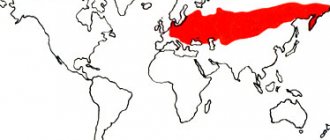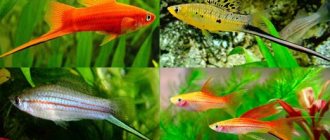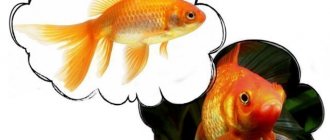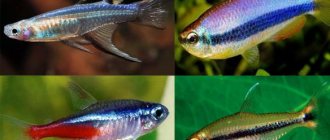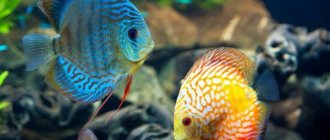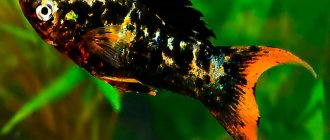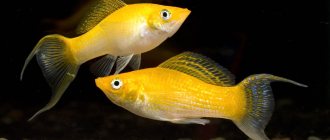The history of goldfish
The aquarium goldfish is a direct descendant of the crucian carp. It appeared more than 1,500 years ago as a result of random genetic connections. Initially, fish were the privilege of only wealthy Chinese. Fish appeared in Russia in the 18th century.
Over the 2000s, thousands of years of history, breeders have developed many varieties of aquarium goldfish.
Optimal parameters
When talking about what temperature the aquarium water should be, the species of the pets is taken into account. For example, the warm-water tropical species Siamese betta needs high-quality water heated to 26 - 28°C. Cold-water species are less demanding of living conditions. Neons in cool water (20 – 22°C) increase their life expectancy. This must be taken into account when forming a group of inhabitants of a common aquarium.
A universal indicator suitable for all aquarium species is 25°C. This temperature can be set in a home aquarium with many different species, and there will be no mistake.
Types of goldfish
A variety of shapes and colors allows you to choose a pet to suit your taste. Goldfish are divided into two types: short-bodied and long-bodied. But type is one thing, but breed is another. Below is a description of popular breeds of aquarium goldfish.
Heavenly eye or astrologer
A beautiful, large animal with a round shape. Body length is up to 15 cm. A special feature of this breed is its telescopic eyes. The color of the stargazer is orange with a golden touch.
Water eyes
The size of this beauty reaches 20 cm. The most common fish are silver, orange and brown.
Veiltail or Fantail
Nature has awarded the veiltail with rich colors: from gold to red and black. Its tail is impressively beautiful. It spreads out in soft waves, falling like a beautiful veil.
Pearl
The pearl was bred in China. It has scales that resemble pearls.
Comet
This beauty has an elongated body. The tail is forked, and the longer it is, the more highly valued the specimen is. The comet is similar to the veiltail, and therefore they are often confused by inexperienced aquarists.
Oranda
A distinctive feature of the Oranda from other breeds is the cap on its head. In all other respects it is similar to the veiltail.
Ranchu
Ranchu appeared thanks to Japanese breeders.
Shubunkin
Another cute Japanese guy. In its homeland it is called calico or sibunkin, but in Russia the name “calico” has stuck. The calico goldfish got its name due to its unusual color. This is a large breed that is kept in bodies of water, such as greenhouse ponds. Not suitable for home keeping due to its size. But, if you want, you will have to purchase a spacious aquarium.
Telescope
Very similar to a stargazer with large, bulging eyes. Grows no more than 12 cm.
Lionhead
The lion head got its name for a reason. At the age of 3 months, growths appear on the head that frame it like a mane.
Description
These wonderful creatures belong to the carp family, the genus of crucian carp. They do not live in nature because they are a species of artificially bred fish. Therefore, they are found only in aquariums and ponds. Their natural ancestor is the silver crucian carp. Initially, this animal could only be seen in the Amur River, but then it was spread by man to Europe, and then to Asia, North America, India, etc.
Crucian carp in reservoirs grows up to 40 cm, and its life expectancy is 10-12 years. The same applies to its aquarium “analogue”. With proper care, goldfish can live just as long. In aquariums, they grow, as a rule, up to 15-20 cm. But if you allocate a fairly large container (swimming pool, pond) for a given pet, then it can grow much larger.
For example, the current record size is 43.5 cm. This is a red oranda from southern China named Bruce. It was specially grown in a large pond with a circular flow. Thanks to constant movement, she had a high metabolic rate, and in 3 years her owner managed to grow her to such a size, thanks to which she was included in the Guinness Book of Records.
All goldfish are divided into short-bodied (telescopes, orandas) and long-bodied (comet). Their name speaks for itself. The former are distinguished by a shorter body. They have a long forked caudal fin, which often has a veil shape. In long-bodied animals, the body is more elongated, and the tail is often not forked.
Due to their different body shapes, these varieties of goldfish have slightly different behavior. Short-bodied ones are slower and calmer. Sometimes they can even hang in one place or even lie on the bottom, spending several hours like this. Long-bodied ones are distinguished by great activity and speed of movement. Therefore, when combining these animals in an aquarium, you need to be careful, since the same comets, due to their swimming speed, can cause stress to such neighbors as telescopes or veiltails.
Goldfish stargazer
Without differences in body shape, all goldfish can be described as follows:
- Various colors, from white or black to orange, red, yellow, etc. There are often individuals with several colors at once, and at the same time they can change their color throughout their lives. So, if, for example, an aquarist purchased a black telescope with a small orange spot, then after some time his pet may completely turn into the color of that spot;
- In good purebred individuals, the body is ovoid in shape. That is, goldfish should be dense, which is why they look somewhat awkward;
- The fins of all species are almost always veiled. There are exceptions like the ranchu variety. They have a large and plump body. Moreover, they completely lack a dorsal fin, and the tail is very small for its size;
- Many varieties have their own specific differences. For example, telescopes and stargazers have large eyes. The oranda has a cap on its head, the water eye has large bags under its eyes, etc.;
- It is not easy to distinguish females from males in goldfish. If the individual is not a year old, then it is completely impossible to understand. Sexual differences are most pronounced during the spawning period. Females become rounder, even bloated. The males begin to chase them, and in addition, tubercles and notches appear on their gill covers and pectoral fins. A “saw” appears on the first ray of the fin. There are other ways to distinguish individuals by sex, but they are usually used by professional breeders. Ordinary hobbyists will either not notice the differences, or simply will not show interest in them (shape of fins, anus, habits when adding a new fish, etc.).
How to choose an aquarium for goldfish?
To choose the right aquarium, you need to take into account only 2 parameters: shape and volume.
Aquarium volume
The volume of the aquarium must correspond to the number of residents. For the comfort of residents, aquarium cubic meters must correspond to the following dimensions: 80 liters per individual. For two pets you need 100 liters. It is necessary to take into account the fact that design additions, in the form of plants, houses, as well as various filters, steal useful volume. Soviet textbooks on aquarium keeping allowed for much smaller sizes, but the fish were also of Soviet origin. They were genetically adapted to such a living area. Nowadays goldfish are brought from China, Japan, and Malaysia, the care and maintenance of which are completely different. Many novice aquarists, not knowing these subtleties, are faced with the death of their pets, blaming the sellers. In fact, the owner is to blame for not adapting the new resident to other volumes. You should not point your head at exhibition aquariums in which the fish live crowded together, like in a multi-story building. There are powerful filters and aerators, the water is changed 24/7, and there is always an ichthyopathologist nearby who monitors their health. It is almost impossible to provide such care at home.
Aquarium shape
There is only one rule here: the aquarium must be rectangular, the length is 2 times the width. Square, too tall and narrow aquariums are not suitable. Very slight curvature is allowed and only for the viewing glass. The side and rear windows must be strictly straight. Round, cylindrical and glasses are not suitable for keeping goldfish. The fact is that the fish's mental health begins to suffer. No matter how absurd this may seem, it is a fact.
Motherland
More than 1000 years ago, in the homeland of goldfish, China and Korea began to engage in fishing. The founders of goldfish - crucian carp - were found in the catches. People started keeping them as pets in glass tanks of water.
The silver carp, paradoxically, is the ancestor of the golden carp.
Later, Chinese breeders began breeding and preserving the best genetic traits in goldfish. As a result of the work, it was possible to obtain many varieties of breeds with different tail sizes, body shapes, colors and life expectancy. They became the founders of truly popular fish breeds.
The first mention of fish with red scales was recorded in 265 AD during the Jin Dynasty.
In the 16th century, red crucian carp came to Japan, where new varieties were developed. Breeders tried to develop harmonious and colorful forms, after which the Japanese were recognized as the founders of the distribution of goldfish.
In the 17th century, trade actively developed. Therefore, pets quickly spread throughout Europe, and later throughout the world.
Water requirements
Water requirements are strict, especially regarding temperature. The temperature ranges from 20° to 23°. For young animals or breeds with a round body, the water should be warmer, approximately 24-25°. Acid-base balance, pH, about 7. Hardness not less than 8°.
The water must sit for at least 24 hours. During settling, a large number of impurities and heavy fractions settle out, and chlorine evaporates. If you had to pour water straight from the tap, then you need to use a water stabilizer. You can purchase it in specialized aquarium stores or pet stores. The water in the aquarium must be constantly filtered. To do this, you need a multi-section filter, which must work around the clock. The power of the device is at least 3 - 4 l/h. The filter must be cleaned weekly. Rinse with aquarium water so as not to destroy the colony of bacteria living in the ceramic compartment.
It is necessary to constantly change the water. This is the name given to partial water replacement and topping it up to normal levels. This should also be done once a week, and if there are many inhabitants, then more often.
In addition to filtration, the water must be constantly aerated. Many filters are equipped with aerators, but it is better to purchase an additional compressor.
Reproduction
To breed goldfish at home, it is better to create a separate aquarium for this - a spawning tank. It will be equipped as follows:
- Vegetation with small leaves is placed on the bottom: riccia, duckweed, periofolia and others.
- The stones and soil are removed; the eggs are better preserved on the empty bottom.
- The water temperature is increased to 24 degrees.
- Provide good lighting throughout the day.
After preparing the conditions for spawning, individuals are selected:
- Males grow to sexually mature individuals by the age of one year, and characteristic white spots appear on the gills.
- Females have a more rounded abdomen for containing eggs.
- For 1 female, 2 males are selected.
- The larger the female, the more eggs she will lay.
- Individuals are added to the spawning tank at the end of March so that the first eggs appear by the beginning of summer.
Goldfish spawn until October, if all conditions are created. Egg laying in females occurs gradually. The males chase the females, they touch the plants and drop 10-15 eggs each time. The grains settle to the bottom or attach to plant leaves. The males immediately water them with seed, and fertilization occurs.
The spawning ground for goldfish can be equipped in different ways, but if the bottom is uncovered, the parents can eat their eggs themselves.
After this, the water level in the aquarium is reduced by 15 cm. After sweeping, the optimal water temperature is maintained. On the 4th-5th day of the incubation period, the juveniles appear. The fry appear weakened and take 2 days to adapt. After which they continue to develop into adult fish.
To remove unfertilized eggs, snails are released to the bottom.
Soil and plants
Goldfish love to dig in the ground. It is better to choose either a very large fraction or a very small one. This is necessary so that they do not choke on grains of sand. It is also necessary to pay attention to the shape of the grains of sand. They should be smooth, without sharp edges or corners. Plants for an aquarium with goldfish are a must. Their role is the same as on land: maintaining ecological balance. In addition, plants for goldfish are vitamin supplements. They chew them with great pleasure. It is better to plant plants in pots. The fact is that the “golden girls” mercilessly undermine them. Plants are changed as necessary.
As for the decor that aquarium owners love to install, they are not needed for golden beauties. Goldfish do not use aquarium shelters. But they can get hurt on all sorts of locks and chests, especially their fins and tails. It’s very disappointing for the owners of “pearls”: having lost a pearl scale, the pet will restore it, but the previous, beautiful rim will no longer be there. So the best decor will be only plants.
Compatibility
You can keep several breeds of goldfish in one aquarium. It is advisable not to combine long-bodied and short-bodied pets. Short-bodied ones are much slower. They will not get enough food. Suitable neighbors:
- zebrafish;
- catfish;
- Cardinals.
Since red crucian carp are cold-loving species, they cannot live in the same aquarium with tropical fish.
Goldfish compatibility chart - an assistant when choosing neighbors.
Also, you should not put small breeds into the tank as neighbors; they can become food for goldfish. The same applies to overly large individuals that will devour crucian carp and bite their tails.
Goldfish nutrition
It is enough to feed your pets 2 times a day. It’s not worth it more often, otherwise these voracious creatures will begin to suffer from overfeeding. Once a week you can and should have a fasting day. The amount of food is calculated empirically, but it has been noted that you need to give as much as will be eaten within 5 minutes. The diet uses dry food, which is soaked in aquarium water for 20-30 seconds. Dry food is alternated with natural plant foods. The fish will like: spinach, lettuce, boiled vegetables, fruits. Delicacy for pets: boiled cereals, meat and liver. For variety, give bloodworms and daphnia. If the bloodworm is frozen, then first defrost it. But they grow daphnia at home on their own.
Is the spool that small?
Goldfish - a descendant of the free-ranging crucian carp, a common fish in our reservoirs - has been raised for hundreds of years in especially comfortable conditions, which, of course, has not been in vain: goldfish have almost lost the ability of crucian carp to survive in the most difficult situations. But the requirements for living conditions remain.
First of all, goldfish need a lot of oxygen. And in this sense, the difference between an aquarium and a pond is very great. Pond farms in which imported fish are grown are usually flow-through, with an extensive filter system. A weakened and stressed goldfish after a long transportation consumes even more oxygen than one in a calm state, and when entering the aquarium, it often experiences more or less pronounced suffocation. Therefore, you should take care in advance to ensure good aeration for your new pets, remembering that in an aquarium with plants, oxygen deficiency can overtake the fish at night - during the first days, the condition of the fish should be monitored, and a “quiet” compressor should be purchased so that did not cause any complaints from the family and did not disturb anyone’s sleep with its rattling.
Goldfish are grown in ponds, in the open air, in conditions close to wild ones. Accordingly, they are accustomed to (and moreover, vitally needed) a large volume of water. This requirement should be observed, as well as a simple rule: at least 50 liters of water per goldfish. Or better yet, a hundred. Moreover, we are talking here specifically about the volume of WATER, and not about the volume of the aquarium, because in the same fifty-liter aquarium there will be much less water: firstly, the vessel is never topped up to the very top, and secondly, a lot of space is occupied by soil, equipment and decorations... After subtracting both of these, 35-38 liters will remain from the declared 50, and the larger the aquarium, the greater this difference will be. To calculate the actual volume of water in your aquarium and get many other useful data, it is convenient to use an aquarium calculator: https://aquaria.ru/faq/aqc.shtml. These same figures will help to correctly calculate population density.
When you go to the store and look for a goldfish, be sure to find out from the seller where it came from. There are usually three options: local billing (you will hear this option extremely rarely, if at all), Chinese or Malaysian (Singaporean). This information may seem insignificant, but only at first glance: the optimal housing conditions for it will depend on the place where the goldfish comes from, which should be created in your aquarium to facilitate adaptation. And they differ very much.
Chinese fish are grown in cooler climates than, say, Malaysian ones. They, like their ancestor, the crucian carp, do not need heating. They calmly tolerate fluctuations in water temperature from 15 to 25 degrees, but above that they begin to suffer. From... suffocation. The higher the temperature of the water, the less oxygen is dissolved in it (and the higher the toxicity of nitrogenous compounds, to which pond fish are not accustomed, but which goldfish themselves secrete in huge quantities). Therefore, they are usually classified as “cold-water” fish, and a heater is not installed in the aquarium. However, this is true for Chinese, but not for Malaysian and Singaporean fish.
Malaysian and Singaporean fish are grown in high temperature conditions - the climate in this area is much hotter. Having become accustomed to such conditions at their “native” fish hatchery, they can adapt to 20 degrees in the aquarium, but the transition should not be abrupt. This should be kept in mind. South Asian fish need heating, at least at first.
quality is primarily affected by feeding. You can feed goldfish with both special and universal food. The goldfish is, in a sense, a real “aquarium pig”, eating everything that is given to it: flakes and granules, duckweed and elodea, white bread and tubifex... But for obvious reasons, food that causes rapid spoilage of water should be excluded from the diet : the fish themselves will be the first to react to deteriorating water quality, and if measures are not taken promptly, everything can end very, very badly.
Overfeeding should also be avoided . In cool water, the metabolic rate is low, and the fish remain full for a long time. They should not be brought to a state of complete saturation, since overfeeding leads to obesity, and obesity leads to rapid death of the fish. In addition, uneaten food that settles to the bottom and gets lost between soil particles will decompose and create a real “gas chamber” for your pet. You should not rely on bottom fish if they live in an aquarium with goldfish - it is better to simply give enough food so that it is completely eaten in a minute or two (for hard, difficult-to-break tablets this time will be longer, but you should also throw them very sparingly ). Goldfish eat a lot, they are prone to gluttony - and they excrete just as much. Ideally, a goldfish should eat according to the principle “more often, but less”: twice or thrice a day, receiving one or two small granules at a time. You can feed once a day, and it is also useful to arrange a “fasting day” once a week, and not feed the fish at all on this day. This will only benefit them.
Now let's talk about what to feed. It is worth considering that in nature crucian carp is a primarily herbivorous fish. In other words, it should be taken into account that, on the one hand, the diet of goldfish should consist of 80% plant components; on the other hand, that in the aquarium they will actively eat small-leaved plants, and when they mature, they will try to eat larger and tougher specimens. It is very useful to feed the “golden fish” with plant food: duckweed, wolffia, sprigs of elodea and hornwort (no matter how tasteless and tough it is, hungry goldfish make short work of it very quickly, and such food is absorbed well). A good option is chopped and scalded lettuce or spinach. This food can be divided into small portions in advance and frozen - then it will stay fresh much longer. Before feeding, pieces of greenery should, of course, be thawed (for example, by washing them in a net under the tap). But meat-based granules (they are easy to distinguish by their dark color and characteristic smell) are not suitable for these fish at all: they quickly spoil the water and also contribute to the development of intestinal disorders in goldfish, such as bloating and intestinal obstruction.
In addition, the aquarium must have a reliable filtration system. The best option is an external canister-type filter, matched to the volume of the aquarium. It is populated by nitrifying bacteria and allows you to maintain consistently high water quality. An internal filter in a large aquarium is not necessary, but if the aquarium is small, then the filter must be more powerful than indicated in the recommendations. So, for a 50 liter aquarium it is worth installing a 75-100 liter filter. High nitrogen is one of the main causes of illness and death of goldfish, so you should not skimp on filtration, especially if you are dealing with goldfish.
We should not forget about water changes. At least 20 and no more than 40% of the aquarium water should be changed WEEKLY. This will reduce the nitrogen concentration and keep the aquarium water clear and clean, without “knocking down” natural biofiltration.
Finally , when planning to get a goldfish, it is useful to get acquainted with at least the very basics of aquarium hydrochemistry and find out for yourself what indicators such as pH (acidity, also known as an active reaction) and GH (total hardness) of water mean. It must be said that goldfish adapt to fairly wide ranges of these water parameters; In addition, in Asian breeding grounds they are raised from juvenile age in water whose composition is not optimal for them. However, it is useful to keep in mind that the best water for goldfish is hard (GH above 12) and alkaline (pH 7.5 or slightly higher). In cities where the tap water is too soft (for example, in St. Petersburg), problems with the health of goldfish arise much more often: in such conditions they may lack mineral salts. If you know that your water is soft - you can verify this using an aquarium test - but you still got a goldfish and see that it feels “out of place”, try gradually increasing the hardness of the water in the aquarium (for example , using special aquarium salts, such as Sera Mineral Salt) or at least a little (just a little - 1-2 teaspoons per 10 liters!) salt the water with ordinary non-iodized table salt. It is quite possible that after this your pet will become much more comfortable.
Breeding goldfish
As soon as the first goldfish appears in the house, the temptation arises to buy several more. If we are talking exclusively about golden pets, then it is clear that there should be only one breed in the aquarium. They are all related to each other, so there is a risk of getting “mongrels”. With such careless species and type maintenance, after a while ordinary crucian carp will swim in the aquarium.
The optimal age suitable for breeding is 2 – 3 years.
To breed goldfish, you need a separate spawning aquarium, in which a male and two females are placed. After spawning, adults are returned to the main aquarium.
The fry will appear in a week. At first, babies feed on the reserves of the yolk sac, and then switch to independent feeding.
What should the water be like in the aquarium?
It is necessary to create favorable conditions in the tank. It is important that the water parameters are suitable for pets. The temperature should be between 19 and 27 degrees. The longer the fish, the lower the temperature can be. For tank inhabitants with a short, compact body, you need to make the water as warm as possible (26-27 degrees). Acidity is about 7 pH.
I use AquaSafe as a tap water conditioner.
You can fill the aquarium with regular tap water. But first, a special conditioner is added to it. The product can be bought in the store. It will purify water from impurities and chlorine.
An important indicator is water hardness. It affects the development of the genital organs, the structure of the skeleton, and the growth of the inhabitants of the aquarium. The optimal hardness for this type of fish is one that has a soft degree of intensity. Medium hardness is allowed. This parameter is measured using a special tester.
Content
First of all, it should be noted that goldfish should never be kept in round aquariums! Firstly, such containers usually have a small volume of about 20 liters, and for one adult it is necessary to allocate at least 50 liters, otherwise the animal will be cramped and will pollute the aquarium very quickly. Secondly, the image in round containers is distorted, which can make the animal feel uncomfortable (it can also see you from its “house,” and not just you). Thirdly, “banks” of this form are inconvenient to maintain.
We recommend reading the article: What kind of fish can be kept in a round aquarium
You cannot keep goldfish in a round aquarium, because...
individuals grow up to 35 cm. The small volume leads to disruption of the growth and development of the skeleton and internal organs, the fish begins to get sick and soon dies. As for the remaining conditions of detention, they are as follows:
- Water parameters . Hardness and acidity are not particularly important. Crucian carp by nature live in rivers with cold water. Accordingly, this also applies to goldfish. For them, the optimal indicator is 22-23 degrees. Can withstand 18-20. It should be noted here that sellers can assure unknowing buyers that telescopes, orandas and other species love warm water up to 30°. This is completely false information. Yes, these animals can withstand similar temperatures, but living in it, their life expectancy is significantly reduced. Sellers usually set it at about 28° in their stores. For them, this is, first of all, a benefit, since many bacteria die in warm water. Accordingly, the less fish get sick, the fewer of them die. This, in turn, affects the store's income;
- Aquarium volume . One individual needs about 50 liters for a comfortable stay. Firstly, this will provide room for movement, and secondly, goldfish create a greater load on the biological balance, and the larger the volume, the easier it will be to care for the aquarium. If the container is large enough, then you can plant a little more pets. For example, instead of five, it is possible to plant six goldfish in a 250-liter “jar”;
- Lifespan . Depends on the quality of care, but under favorable conditions it can be 10-12 years or even more;
- Soil . It can be almost anything. But there are some nuances here too. Firstly, the stones should not be sharp, since these pets love to dig in the ground and it is important that they do not get hurt. Secondly, you need the right faction. The stones should be either small or large, but not medium. This is explained by the same familiarity of these animals. When searching for food, they can take a stone into their mouth, and if they come across a fairly large one, the fish will not be able to spit it out, and then the owner will have to do it themselves, using tweezers. Therefore, it is better to take large pebbles, granite. Such stones will not fit in the oral cavity. Fine quartz and basalt are also suitable, and then the pet can spit them out without any problems;
- Plants . Here with the selection everything is much more complicated. Goldfish are herbivores by nature, and their size and burrowing habits make it difficult to find a suitable plant. They definitely shouldn’t buy tender bushes, otherwise they will simply eat them. It is better to take something with a powerful root system and hard leaves. For example, these are Anubias, ferns, Echinodorus, Cryptocoryne. You can also try planting vallisneria, nymphea, marsilia. However, they will take root only if these animals have been provided with an appropriate diet, and they will not look at these plants as food for themselves.
Who does he get along with?
Goldfish prefer to live with similar individuals. It is also not recommended to place fish of different body lengths in one vessel. Different species differ not only in body size, but also in character.
If golden representatives are placed with other species of fish, there will be a risk of damage to the fins, since golden individuals need a lot of space. There are species of fish that are very small in size, so goldfish can easily eat them.
Despite the fact that goldfish are peaceful fish, it is important to know that combining them with other species reduces their life expectancy and health. As a result, compatibility with other fish becomes a difficult task.
Reproduction and care of fry
It is possible to distinguish a male from a female only during the spawning period. At this time, the abdomen of the female has an asymmetrical shape, and the male develops white specks on the gills.
For propagation, small-leaved plants or a net with large bunches of washcloths are attached in the corners at a distance of 3 cm from the bottom. One female requires two males. The female lays up to 3000 eggs in 5 hours. After this, the fish are removed, and the temperature in the aquarium is maintained at around 15-25 °C.
The tank is placed away from sunlight. Those eggs that have died are removed with the help of snails planted in the aquarium.
In a week the fry will appear. They need to be fed 4-5 times a day with small algae and plankton. As they grow older, live and store-bought food is added to the diet. In the third month, the fish acquire a color characteristic of the species. As the fry grow older, it is necessary to sort them, removing defective individuals from the aquarium.
Diseases and their prevention
Like all living things, goldfish get sick. In sick individuals, the dorsal fin is compressed, the scales are protruding, the stomach is swollen, and the eyes protrude. In addition, their appetite decreases and lethargy appears. This often happens due to incorrect content. Every water contains parasites and pathogens.
With proper care, the immune system of fish is able to repel attacks from harmful microorganisms. When an aquarium resident constantly experiences stress due to unfavorable factors (incorrect temperature, wrong food, wrong water acidity, overcrowding of the tank, aggressive neighbors), this weakens his immunity and leads to illness.
Early treatment promotes recovery. When the fish gets sick, it should be moved to another container with a water volume of 35-50 liters and kept there for at least a month.
If your pet's condition is satisfactory, you may not give him medication. In severe cases, drugs should be added to water.
Care
Considering that the golden inhabitants are quite whimsical, it will be necessary to take into account several important points regarding maintenance and care, because how many years they will live will depend on this.
How to introduce it into an aquarium
Before introducing residents into the aquarium, the water must settle and be saturated with oxygen. If the fish are from a pet store, then water from the store aquarium should not be allowed to enter the home aquarium. To adapt, you can move them to a container containing water from the store, and gradually add water from the aquarium to it.
Varieties
Selective breeding has achieved great results; the goldfish family has about 300 varieties. Goldfish differ in color, shape, size and type of fins.
The most popular types of breeds:
- Ordinary. Contained in indoor aquariums and open containers, the color of the scales is red-orange, the body length reaches 40 cm.
- Veiltail. It has a long tail fin and enlarged eyeballs, and is calm and leisurely.
- Fish telescope. A distinctive feature is large eyes; the shape of the eyeballs differs depending on the species.
- Jikin butterfly. The fin has a forked shape, reminiscent of butterfly wings. Representatives are only divorced at home.
- Ranchu. It is distinguished by a flattened body and small fins; there are no fins on the back.
- Ryukin. It has a curved back and is extremely slow in its movements. Loves warm conditions.
- Oranda. Outwardly it resembles a telescope, but on the forehead it has a fatty growth in the form of a golden cap.
- Bubble Eye. The fish has characteristic bags around the eyes, which are filled with liquid; their size can reach 25% of the size of the entire fish.
- Pecilia. It has a diamond-shaped body and a wide caudal fin, the head is small compared to the body. The most popular species for keeping in home reservoirs.
What should the water temperature be?
Goldfish belong to cold-blooded organisms, and they can live at temperatures that are comfortable for humans. However, strong changes in temperature (for example, in an office space on a winter night), especially in miniature vessels, can kill them. You also need to add new water with caution, the temperature of which should be the same as in the aquarium. This point should be monitored with special attention.
A temperature in an aquarium for goldfish, especially small ornamental ones, less than 10 ° C is risky for their health. But comets and ordinary goldfish can also live in harsh environments. Too high a temperature (above 30° C) is dangerous for pets. The most suitable temperature for all types of fish is 20 – 22° C.
